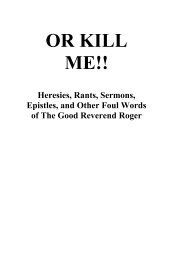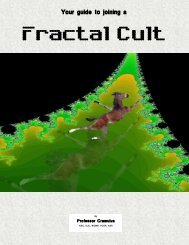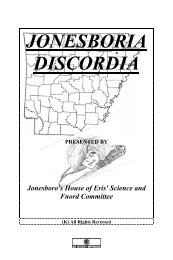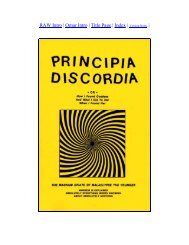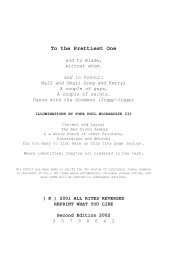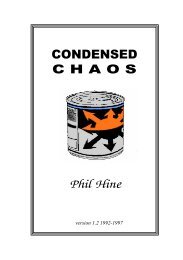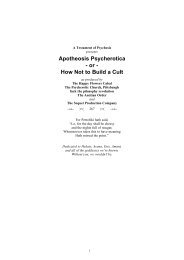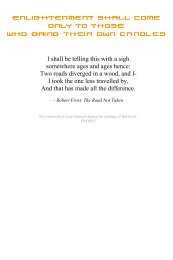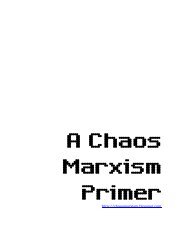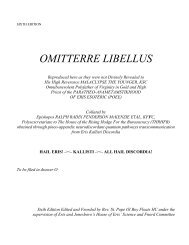Coincidance - Principia Discordia
Coincidance - Principia Discordia
Coincidance - Principia Discordia
Create successful ePaper yourself
Turn your PDF publications into a flip-book with our unique Google optimized e-Paper software.
98 COINCIDANCE<br />
contains the whole, Finnegans Wake is structured in puns and synchronicities<br />
that "contain" and reflect each other, creating the closest approximation of<br />
an infinite regress ever achieved in any art-form. The absent is everpresent,<br />
the dead are all alive, and the abyss of uncertainty appears in every<br />
multi-meaningful sentence. (This will be illustrated below.)<br />
The revolutionary nature of this dream-book can be indicated by the fact<br />
that Joyce's notes include four separate symbols to stand for that which in a<br />
day-time novel would be the hero or protagonist: and . There<br />
is, as we have said, no "character" dominating this book, but rather what<br />
mathematicians would call a system function. The first person "dead" or missing<br />
in Finnegans Wake is the conscious ego we normally take for granted. We can<br />
only deduce him, as it were, from the system of which he is part.<br />
The ego Joyce's ), we know, is one Humphrey Chimpden Earwicker, a<br />
publican (inn-keeper) in Chapelizod, a western suburb of Dublin. Probably,<br />
he was a sea captain for many years before settling down; almost certainly,<br />
he is having this dream in 1921 or when the Irish Revolution was at its most<br />
violent and any stranger in the park might be an I.R.A. terrorist, any three<br />
British soldiers might arrest you "on suspicion." Earwicker is terrorized,<br />
throughout the dream, by ambiguous strangers in the park and three<br />
accusatory British soldiers.<br />
To try to "understand" Finnegans Wake in terms of the life of or<br />
Earwicker, the conscious ego, is entirely mistaken, however. The Ego that<br />
seems so real in day-light is "dead" or comatose in the dream-world, and<br />
Finnegans Wake is dominated by those trans-Ego functions Joyce abbreviates<br />
as and<br />
has some of the qualities of Freud's personal unconscious and also of<br />
his "censor band." Joyce identifies it also with Stonehenge and other Celtic<br />
monoliths (because of shape?) and, by association, with human sacrifice,<br />
religion, guilt, anxiety and the fear of authority-figures. On this level, you<br />
will find on every page of Finnegans Wake disguised, distorted and sometimes<br />
deeply hidden ("repressed") images of everything that is taboo in Catholic<br />
Ireland, especially incest, homosexuality, voyeurism, exhibitionism, urination,<br />
defecation, masturbation, patricide, regicide and cannibalism. In Jungian<br />
terms, this is the Shadow of the waking Mr. Earwicker; it is the Mr. Hyde<br />
within every Dr. Jekyl.<br />
is the "collective unconscious" of Jung, the "phylogenetic unconscious<br />
of Grof, the "neurogenetic archives" of Leary and/or the "morphogenetic<br />
field" of Sheldrake—to use four modern scientific metaphors. In older<br />
mystical languages it is called the " Akashic records" in Theosophy, the "long<br />
memory" in Hermetic texts, the aliyavijnana ("treasury mind" or " storehouse<br />
mind") in Buddhism. On this level, every page of Finnegans Wake is drenched



